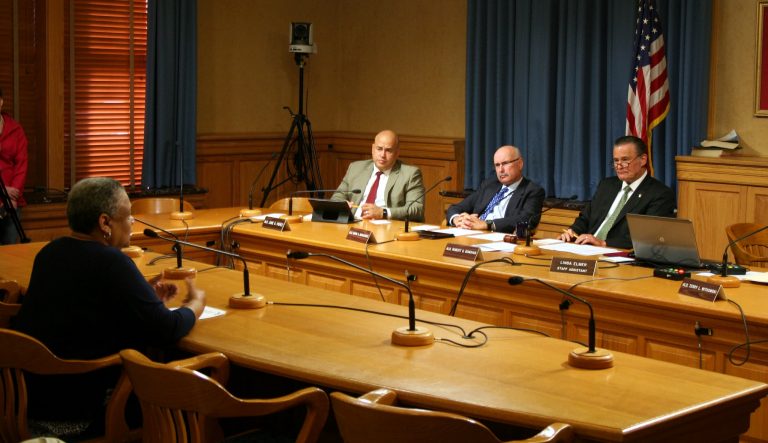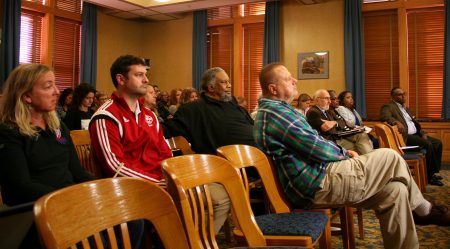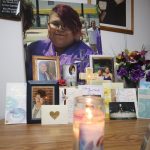Citizens Condemn Proposal for More Cops
Different practices, not more police needed, community groups tell aldermen at city hearing.

Patricia McManus, president of the Black Health Coalition, addresses the Public Safety Committee. Photo by Jabril Faraj.
Community organizations from across Milwaukee sent a clear, unified message to the Common Council at a recent Public Safety Committee hearing: more police will not be sufficient to reduce violence and crime in the city.
The packed hearing was called to solicit feedback on the committee’s draft public safety plan, which was released shortly after violent demonstrations ripped through the Sherman Park neighborhood in response to the police shooting of Sylville K. Smith, a 23-year-old black man. The plan recommends adding 280 police officers, 150 sheriff’s deputies and increasing time behind bars for juvenile offenders. Four additional hearings will be held to collect resident feedback.
Ald. Bob Donovan, chair of the committee, defended the plan and its focus on law enforcement. “This is just one in a series of plans that will be coming out of the Common Council,” he said, adding that other plans will focus on jobs and economic development, youth and education, and community engagement.
Many organizations that are a part of the Community Coalition for Quality Policing, including the ACLU of Wisconsin, Milwaukee NAACP, Milwaukee Inner-city Congregations Allied for Hope (MICAH) and the League of United Latin American Citizens (LULAC) raised specific concerns about the tactics and strategies of the Milwaukee Police Department (MPD).
“The answer to the unrest in Milwaukee in August of this year, and to the violence in Milwaukee in general, is not more police,” said Joseph Ellwanger, a former pastor of Cross Lutheran Church representing MICAH. “We need a change in police strategy.”

A crowd largely made up of individuals representing community organizations looks on during a Public Safety Committee hearing to solicit feedback on the its draft public safety plan. Photo by Jabril Faraj.
Wisconsin ACLU Executive Director Chris Ahmuty criticized the use of pretextual stops — traffic stops for minor infractions, meant to deter more serious crime — saying the practice undermines the good things that are happening in terms of community engagement, on the part of police.
According to MPD standard operating procedure as of August 2014, MPD uses the stops to “make contact with citizens, target commonly stolen vehicles and focusing our efforts in those neighborhoods most afflicted by crime victimization. The preferred outcome of our traffic stops in which no crime has been interrupted or discovered is a warning.”
A 2011 Journal-Sentinel analysis of traffic stops made by MPD showed that black drivers were seven times more likely than white drivers to be pulled over by police; Hispanics were pulled over nearly five times as often as white motorists. As many as 200,000 stops occur yearly.
“This city’s already fearful of police officers, and a lot of the time these officers are saying things to people that are making people even more fearful,” said Malcolm Hunt, a bishop at Least of These International Ministries who was a Milwaukee police officer for 25 years and works with families affected by homicide. He said residents don’t talk to officers because of a lack of sensitivity and confidentiality on the part of police.
The draft plan cites a recent increase in the number of violent crimes, including a 70 percent increase in homicides from 2014 to 2015 and a 68 percent increase in auto thefts since 2013, as a reason for the recommendations. The Milwaukee Police Department’s 2016 operating cost of $277 million is 45 percent of the city’s total $615 million budget.
A 2016 analysis by researchers from the University of Cincinnati that looked at 62 studies and 229 findings of police force size and crime between 1971 and 2013 found that “there is no good reason to suspect that marginally more police reduce crime at a meaningful level.” The paper concludes that “changing policing strategy is likely to have a greater impact on crime than adding more police.”
The new strategy called for fewer arrests, instead focusing on solving the problems that cause people to commit crimes. Jeanne Geraci, executive director of the Benedict Center, suggested MPD implement a street-level pre-booking diversion program that would reduce arrests and get people help.
In Cincinnati, between 1999 and 2014, police use-of-force incidents dropped 69 percent; citizen complaints declined 42 percent; citizen injuries were down by more than half. Violent crimes declined by almost 50 percent and misdemeanor arrests dropped from 41,708 in 2000 to 17,913 in 2014.
“That’s significant; that’s impactful. You talk about data-driven results. That’s something that I think that we could benefit from,” said Milwaukee NAACP President Fred Royal.
“The Milwaukee Police Department has been using problem-oriented policing strategies for decades in many different forms,” said MPD Sgt. Timothy Gauerke. “The Milwaukee Police Department has been and continues to be engaged with all residents of Milwaukee.”
Gauerke added that citizen complaints decreased 38 percent between 2013 and 2015; use-of-force incidents were down 25 percent over the same period. The number of citizen complaints in 2014 was slightly above 2001 levels, due to a spike in complaints between 2007 and 2012, according to the City of Milwaukee’s most recent budget.
“There are some things that are in place that they are trying to do,” said Brenda Hart-Richardson, an Amani resident who has been through abbreviated police training. “But, when they’re on the street, are they practicing what they’re being taught?”
Octavia Parker, also an Amani resident, suggested more regular contact with officers might help to decrease fear, both for old and young residents. “We had beat officers that walked the beat,” she said. “It wasn’t about the baseball cards (that officers handed out to children) — it was about the relationship that they had with the neighbors and the children. I think we need to get back to that.”
The draft plan recommends more walking and biking beat patrols. Royal also said body cameras that cannot be turned off could help improve relations.
Rethinking public safety
The plan cites “multigenerational poverty, joblessness, breakdown of the family, widespread drug abuse, a challenged education system and the lingering effects of the housing foreclosure crisis” as the root causes of Milwaukee’s situation. However, it provides no recommendations to address these issues.
“Police can’t do it all, and shouldn’t be expected to do it all,” said Elysse Chay Wageman, chair of the public policy work group for Beyond the Bell.
Added Sarah Milnar-McLaughlin, director of partnerships and community engagement at the Center for Youth Engagement, “We need to change our definition of public safety, as it is reflected in this plan, and as it is reflected in the city budget.”
“The key to preventing darkness and destruction in the City of Milwaukee is to attack the conditions of misery and want,” said Mose Fuller, pastor of St. Timothy Community Baptist Church, 3701 N. Teutonia Ave.
“We spend way too much time on rituals and politics than on problem-solving, when it’s obvious how hungry everybody is for the solutions,” said Tammy Rivera, executive director of the Southside Organizing Committee. She added that city leaders must make difficult decisions and sacrifices now.
Jay Holmes, who lives in Sherman Park, criticized the committee, saying it should have asked for resident feedback before releasing the plan. He said not enough has been done to provide opportunity and address the conditions people in Milwaukee face.
He added, “You’re not going to be able to talk your way out of this problem, and you’re not going to be able to pray your way out of this problem. It takes real action. The first action is: give everybody justice.”
Additional hearings for resident input will be held at 9:30 a.m. on Saturday, Oct. 15, at Obama High School, 5075 N. Sherman Blvd.; Saturday, Oct. 22, at South Division High School, 1515 W. Lapham Blvd.; and Saturday, Oct. 29, at Pulaski High School, 2500 W. Oklahoma Ave.
This story was originally published by Milwaukee Neighborhood News Service, where you can find other stories reporting on fifteen city neighborhoods in Milwaukee.
Political Contributions Tracker
Displaying political contributions between people mentioned in this story. Learn more.

















There are plenty of successful programs in Milwaukee that already engage young people positively and thus discourage violence and negative behavior. However, most struggle for funding that could help them scale up.
The city needs to value and support these programs based on sports, arts, urban agriculture, STEM and other types of mentoring and paths to success. Enough already with the obsession with law enforcement as the only factor in promoting safety!
There are plenty of successful programs in Milwaukee that already engage young people positively and thus discourage violence and negative behavior. However, most struggle for funding that could help them scale up for far greater impact.
The city needs to value and support these programs based on sports, arts, urban agriculture, STEM and other types of mentoring and paths to success. Enough already with the obsession with law enforcement as the only factor in promoting safety!
It’s easy for the representatives of those community groups to say we don’t need more police, when all of the police are in their neighborhoods. There are parts of Milwaukee where the citizens only see the police that are coming to and from work.
Well this title is misleading… because the proposal is not just for more cops. There are 23 individual recommendations and a number of them deal with community policing and improving community relations.
The only people not asking for more cops are the ones who live in neighorhoods that the police are focusing on. If they don’t want the police presence then PLEASE send them our way. Tired of calling in active crimes and having the cops show up long after it is done. Same with the 911 operators, please get more! It’s unbelievable that you can call the emergency dispatch and be put on hold!
Is crime becoming more of a serious problem in your neighborhood AG? You defended it over and over again as a very safe place in the long conversation with Dean.
I heard an interview recently with a criminal justice expert. Can’t remember their name. They said more officers is useless if there are serious community relations problems. If part of the problem is officer mistrust and officer conduct, more of them isn’t going to solve anything.
Yes, Vincent it has become more and more of an issue. In my discussion with Dean I was having a good time prodding him but my main point was that crime wasn’t a big enough issue that people should fear living, working, or shopping in the area.
However, crime has been on a big upswing… especially property crime. Car thefts and breakins, garage and home invasions, and other things of this nature has become more and more common. We, and many other “nicer” areas of Milwaukee, are having a big problem with inner city youths finding an easy target in our neighborhoods. And no, this isn’t a stereotype, this is info we’ve received from our district captain and liason officer.
They’ve stepped up patrols a bit in response, but they say they just don’t have the resources to do it consistantly and at a level needed. not to mention non-emergency calls will take hours (if ever) for them to respond and even emergency calls take far too long. That’s on top of being put on hold when you call 9-1-1. Yes, you are put on hold!
The whole community – police relations concept I think is valid… but there is a point where you really do need more resources and “boots on the ground.” We have a great relationship with our district, but if they can’t send patrol cars or respond timely… thats a problem.
If residents of a neighborhood don’t want as many cops, as I said before, please send them my way.
AG, I completely agree with everything you said. We all can see that car jacking’s & armed robbery’s are up, especially in neighborhoods that are typically relatively safe. I personally know many people in the law enforcement industry and all of them have commented that we need more police on the street. While the city of Milwaukee wants you to believe that it would not make a difference, it is frustrating to think that we cannot hire more Police because it is not in the budget. The city is growing and more density always equates to more crime. We continue to allow more apartments to be developed yet we are not doing anything to protect our long time residents. Stop with the apartments and add more police, please.